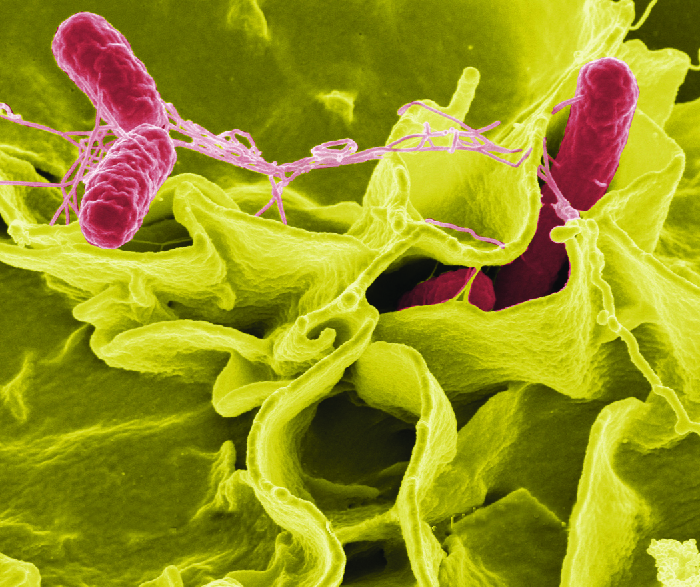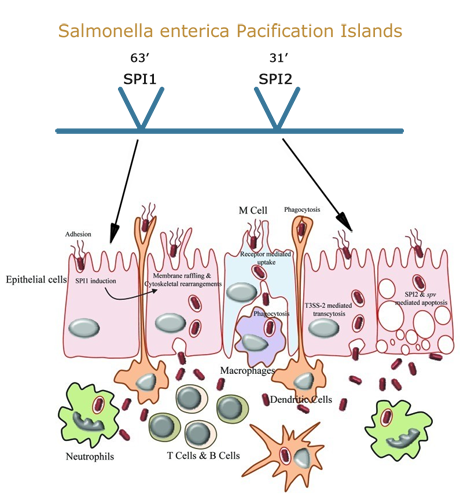Bacteria
The Intelligent Design Prize in Bacteria 1885
Advanced Information
The Intelligent Design Prize
in Bacteria 1885
Salmonella enterica serotype Typhi
The Intelligent Design Prize in Bacteria 1885
The Intelligent Design Prize in Bacteria 1885 was awarded to Salmonella enterica for its contribution to Typhoid Fever
Learn more
Flagella spearhead Salmonella's invasion of the host
Salmonella enteric Typhi is tasked with pacifying its host with enteric complications, infectious myocarditis, infectious-toxic shock, and failing that, through perforative peritonitis or pneumonia. It enters the mouth then crosses the mucosal epithelium of the intestinal tract and fans out to major organs—liver, spleen, bone marrow, heart, gallbladder, and occasionally the brain. Entering the lymphatic and circulatory systems sets S. Typhi apart from most enteric bacteria which merely colonize the lumen of the gut and harass the host with nausea, vomiting and diarrhea.
S. Typhi must cross the gut epithelium or fail. To this end, Salmonella is peritricious: it bristles with flagella. These critical assets are designed to do far more than move the microbe through the mucous layer to the epithelium. They participate in adherence. They are required for macrophage uptake and during enterocyte invasion, their thrashing augers the bacteria into the cell.


“As humans are essential for the survival of S. Typhi, it is reasonable for S. Typhi to have developed multiple means to sustain its population to avoid its potential extinction…we speculate that typhoid toxin helps maintain S. Typhi’s long-term survival and transmission by targeting the immune system and the central nervous system.”
Chong et. al., ncbi.nlm.nih.gov/pmc/articles/PMC5482304/
Pacification Islands weaponize Salmonella
What sets S. Typhi apart from the many mediocre strains of Salmonella? S. Typhi is virulent, equipped with the offensive and defensive weapons that pacify it’s host. It can cross the gut epithelium with impunity and then fend off the hostile forces that await: antibodies, neutrophils, macrophages, dendritic cells, T and B lymphocytes, and dreaded complement. It moves through M cells or enterocytes by allowing itself to be engulfed into a phagosome, then releasing effector molecules that prevent the vacuole from fusing with a lethal lysosome. By sheltering in a macrophage, the microbe both evades counterattacks and is carried throughout the host by the circulating macrophage: Invasion by Evasion.
Salmonella Typhi is weaponized with Salmonella Pacification Islands, contiguous collections of genes that are dropped as a module onto the Salmonella chromosome. With the 25 genes of SPI1, Salmonella enters epithelial cells by deploying a type-3 protein secretion system to shoot effector proteins into host cells, producing ruffling membranes through which it burrows in. SPI2, with about 15 genes, enables Salmonella to defilade and proliferate within a macrophage.
From defense to offense: within a host cell, S. Typhi releases Typhoid Toxin, a powerful exotoxin that preferentially attacks the target’s immune system and the central nervous system. An SPI containing 5 genes provides the firepower.
Despite its many strategies of subversion, survivability and virulence, today S. Typhi boasts only a modest case-success rate. In 2010, of its 26.9 million cases, only 1% were dispatched. Past campaigns are far more impressive, neutralizing entire civilizations. In the 16th century, when Salmonella travelled from the Old to the New World, it found little immune opposition. In this fertile target for microbial colonization it achieved rates of 80%.

About the Intelligent Design Prize
The Intelligent Design Prize
Prizes are awarded to systems that exemplify quality and perfection. Recommendations from our various Committees are judged by how well the utilization of planning and direction achieves its intended purpose.
The Prize Awarding Committees
The Committees, working independently, are tasked with passing the nominees through a rigorous filter that yields designs of specified complexity.
Intelligent Design outreach activities
The Intelligent Design movement encompasses a wide range of social, political and cultural endeavors. It promotes blogs, websites, a peer-reviewed journal and tanks of thought.
Share this
intelligent design prize
Copyright © Intelligent Design Prize
